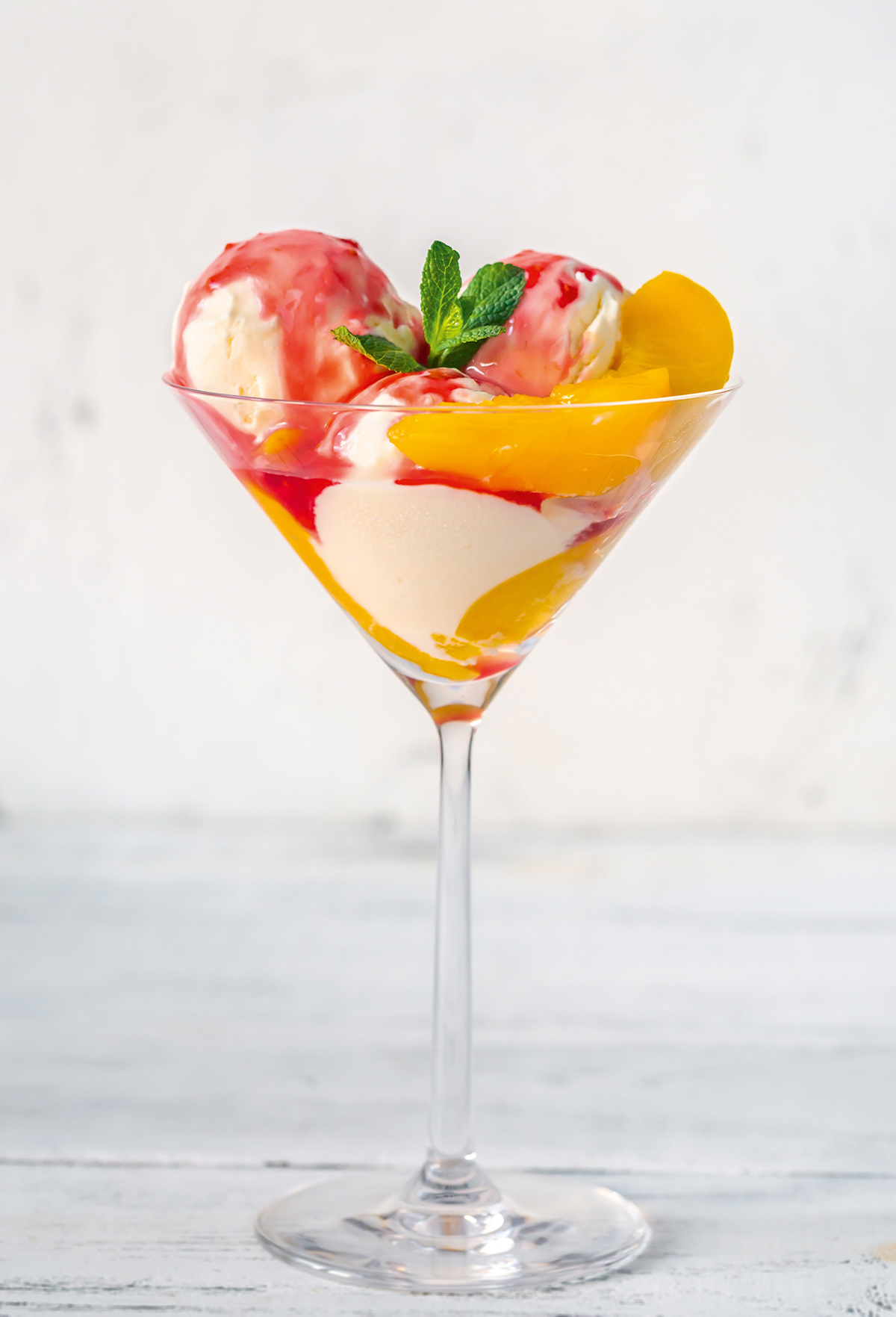Tom Parker Bowles on peaches, his mother's favourite fruit... and how to turn them into a dessert that's 'summer on a plate'
'This column was very much her idea,' says our food columnist Tom Parker Bowles of his piece for this week's guest editor. And how could he refuse? She is not only The Duchess of Cornwall, but also his mother.


‘Do I dare eat a peach?’ asked J. Alfred Prufrock in his eponymous love song, T. S. Eliot’s paean to male anguish, awkwardness and indecision. Compared with his desire to wear ‘white flannel trousers, and walk upon the beach’, biting into this golden orb, fecund and tremulous with juice, seems decidedly decadent.
For this is the most sensuous and self-indulgent of fruits, all luscious lines and concupiscent curves, its syllables as soft as its flesh — Venus and Marilyn, lust and lasciviousness, pure sybaritic excess. When it comes to eating peaches, etiquette be damned. Who could gaze upon a ripe specimen, still warm from the sun, and decide there’s a place for knives and forks? Peaches must be devoured on the spot, the nectar cascading down one’s chin.
All peachy. Peachy keen. A peach of a goal. There’s little doubt that the fruit is held in high esteem, synonymous with beauty, joy and delight. The Chinese have long revered it, seeing the blossom as a symbol of long life and those mythical peaches of immortality, which fruit every 6,000 years, the key to keeping the gods eternally alive. A Chinese native, the tree came into Europe via Persia (and was brought to the UK with the Romans), hence the Greek melon persikon and Latin malum persicum, both meaning ‘Persian apple’. The latter term was shortened to perscia, which became the Italian pesca, French pêche, Russian persik and British peach.
Although the yellow-fleshed varieties are more common (and a nectarine is but another variety, albeit smooth skinned), it is perhaps the white that is most revered of all. I remember the tale of a grand old duke who, upon being asked by his son if he could get a lift back to London one Sunday night, replied that would be fine — but he’d have to sit in the back, as the first harvest of his hothouse-grown white peaches were in the front. And rather more important than mere heir.
"White peaches tend not to linger too long. Once you’ve tasted one of these buxom beauties, those hard supermarket varieties, bred for transportation over taste, seem very dull indeed"
The most famed variety of all was the legendary Montreuil, individually packed into its own dark-blue box, beloved by Louis XIV and Edward VII, too. The latter, dining one day in Paris with an admiring jeune fille, had ordered a few for pudding, but, when the bill arrived, was aghast at their price. ‘Peaches must be very rare this year,’ growled His Majesty. ‘Ah yes, Sir,’ replied the maitre d’, with admirable sangfroid. ‘But not as rare as kings.’
My mother is a keen grower of white peaches (the subject of this month’s column was very much her idea) and they certainly don’t want for attention. And although occasionally making it from greenhouse to kitchen — and sometimes even into a fruit salad (cooking would be heresy) — they tend not to linger too long. Once you’ve tasted one of these buxom beauties, those hard supermarket varieties, bred for transportation over taste, seem very dull indeed.
Exquisite houses, the beauty of Nature, and how to get the most from your life, straight to your inbox.

Recipe: Peach Melba
The original recipe comes from Auguste Escoffier, named in honour of that great Australian soprano Dame Nellie Melba — but his instructions are curt, to say the least.
This is why I turn, as I do so often, to Nigella Lawson. ‘This is it — summer on a plate,’ she writes in Feast. ‘Most days I take the view that cooking fruit rather loses the point of its delectable freshness, but this somehow intensifies it. Besides, most peaches are disappointingly hard or lacking in luscious peachiness, so poaching the fruit gives even lacklustre peaches the boost they need, restoring them to their rightful glory.’
Ingredients
Serves 8
- 750ml water
- 700g caster sugar
- Juice of half a lemon
- 1 vanilla pod (split lengthways)
- 8 peaches
For the raspberry sauce
- 375g raspberries
- 25g icing sugar
- Juice of half a lemon
To serve
- 1 large tub vanilla ice cream
Method
Put the water, sugar, lemon juice and vanilla pod into a wide saucepan and heat gently to dissolve the sugar. Bring the pan to the boil and let it bubble away for about five minutes, then turn the pan down to a fast simmer.
Cut the peaches in half and, if the stones come out easily, remove them, if not, then you can get them out later. Poach the peach halves in the sugar syrup for about 2–3 minutes on each side, depending on the ripeness of the fruit. Test the cut side with the sharp point of a knife to see if they are soft and then remove to a plate with a slotted spoon.
When all the peaches are poached, peel off their skins and let them cool (and remove any remaining stones). If you are making them a day in advance, let the poaching syrup cool and then pour into a dish with the peaches. Otherwise, just bag up the syrup and freeze it for the next time you poach peaches.
To make the raspberry sauce, liquidise the raspberries, icing sugar and lemon juice in a blender or else a processor. Sieve to remove the pips and pour this fantastically hued purée into a jug.
To assemble the peach Melba, allow two peach halves per person and sit them on each plate alongside a scoop or two of ice cream. Spoon the raspberry sauce over each one and put the remaining puce-tinted red sauce in a jug for people to add themselves at the table.
Tom Parker Bowles is food writer, critic and regular contributor to Country Life.
